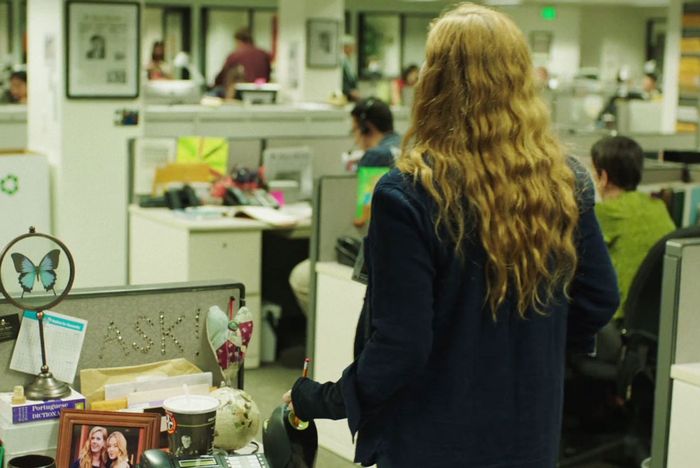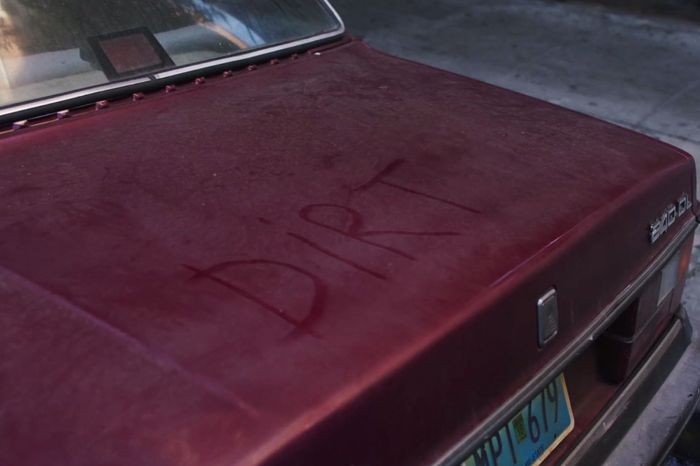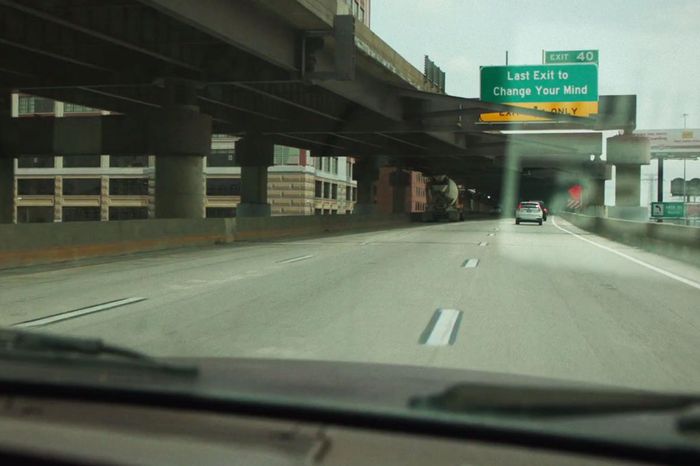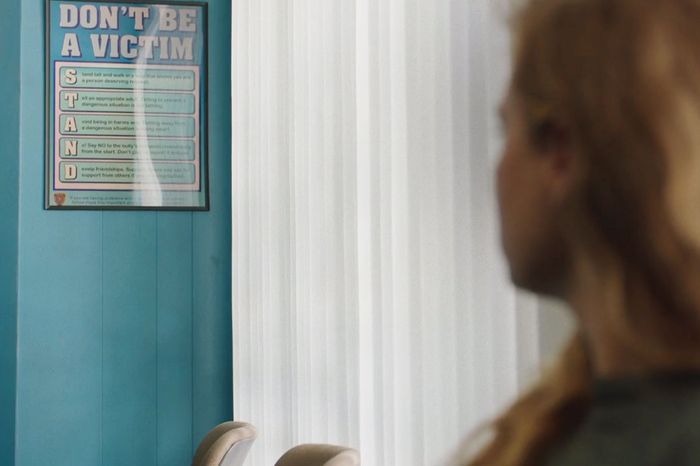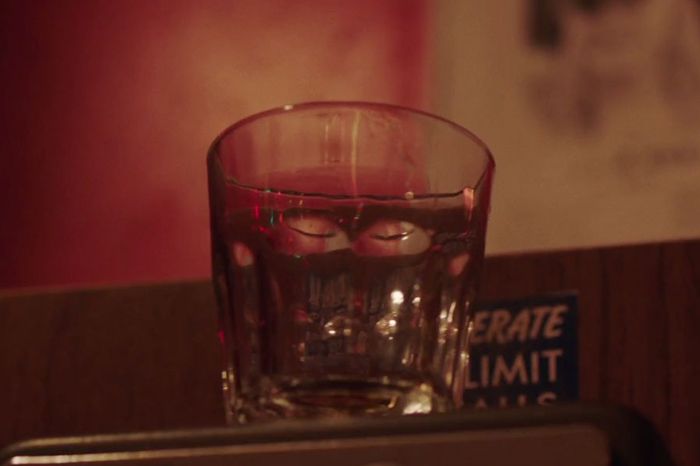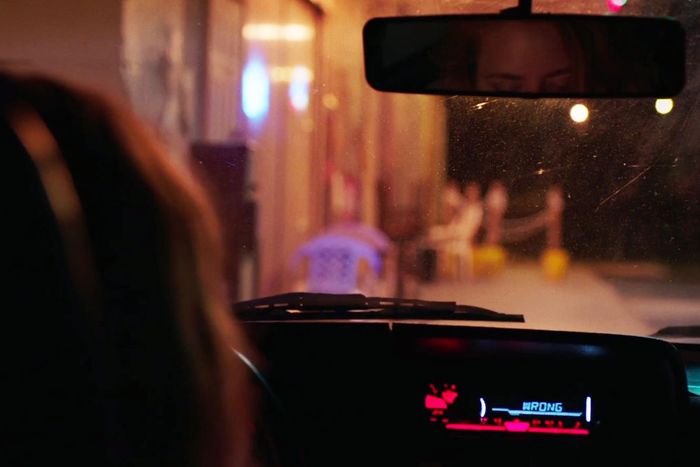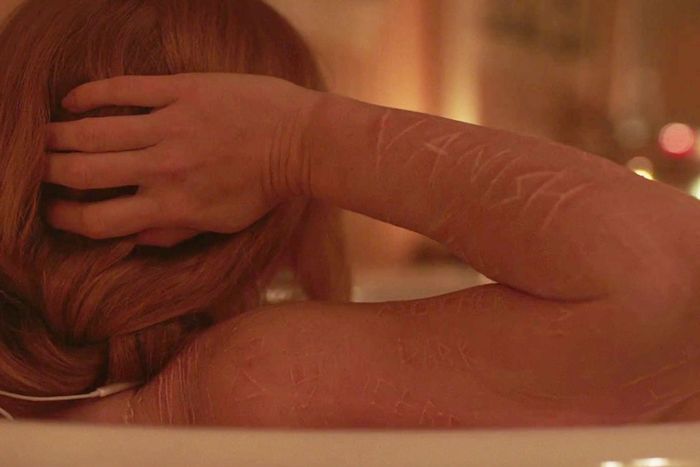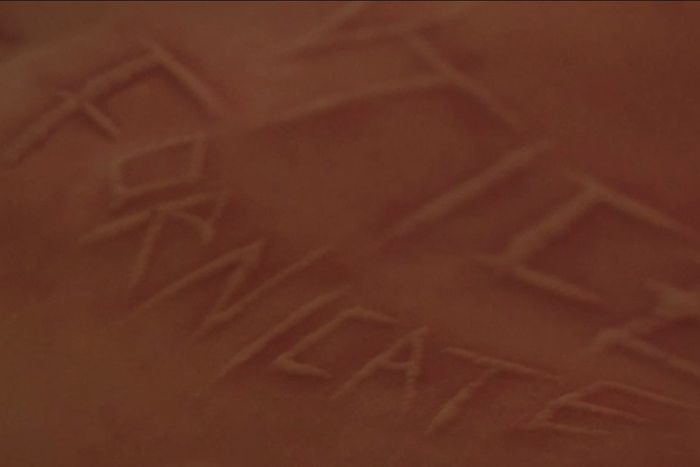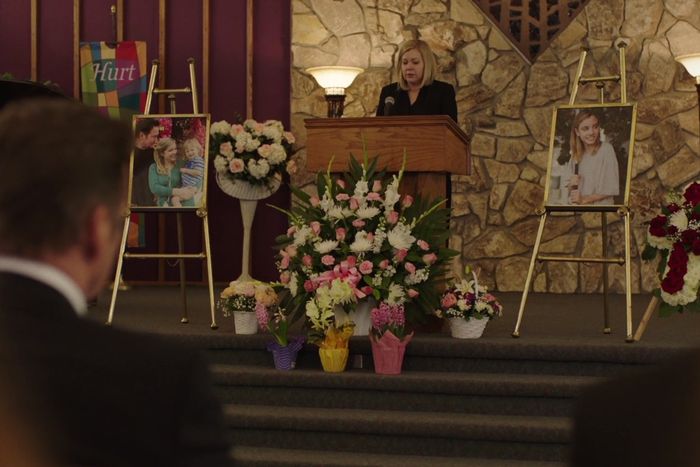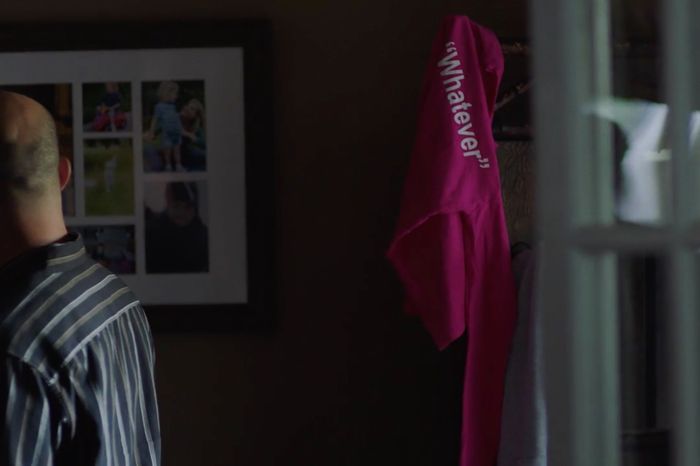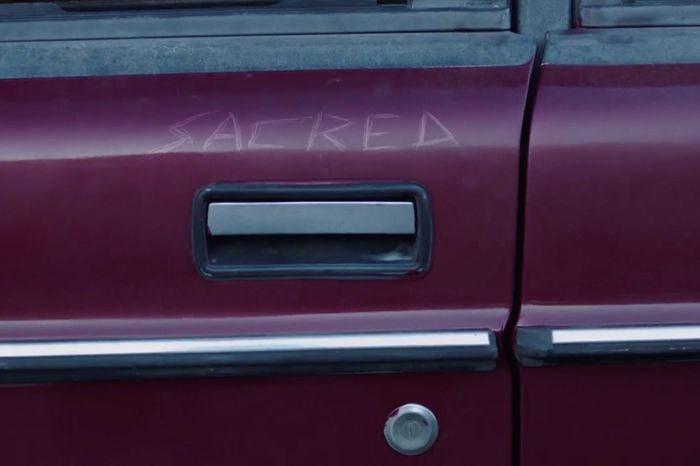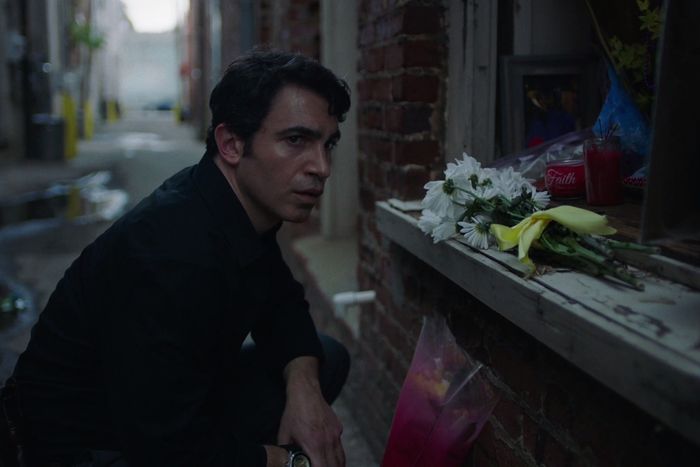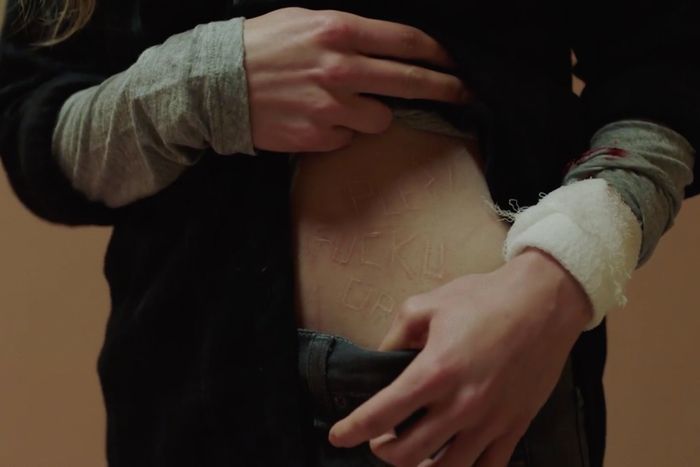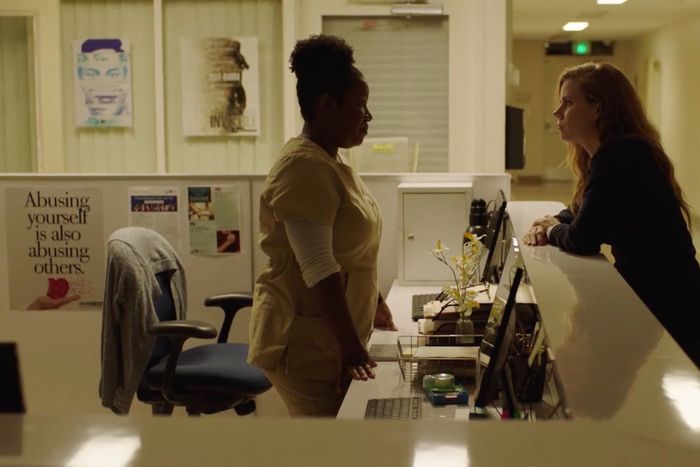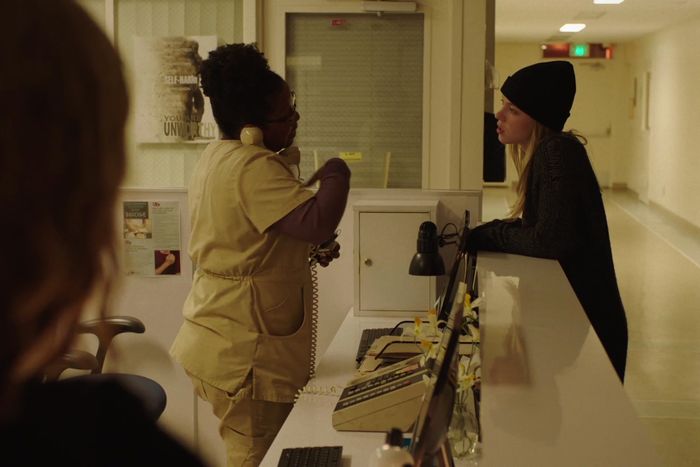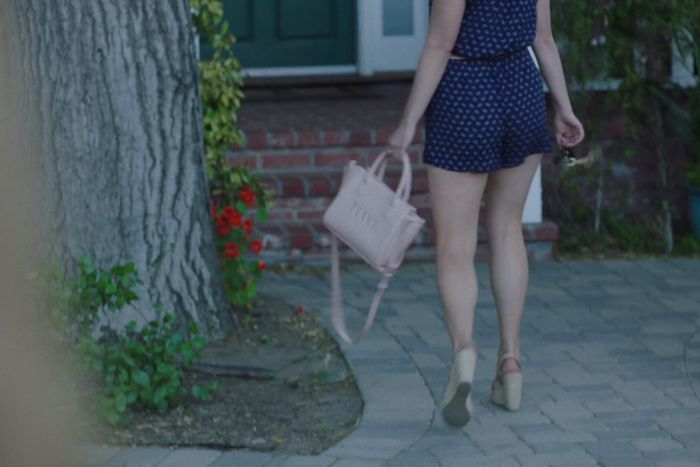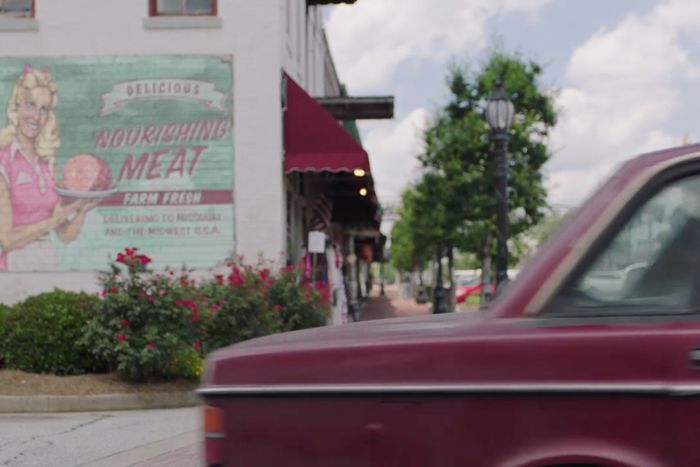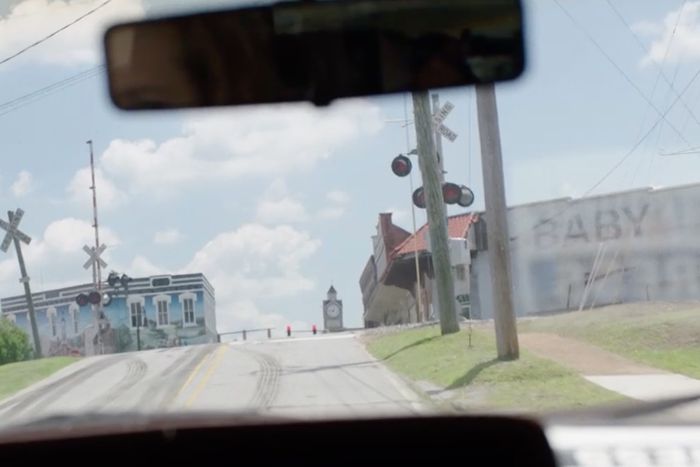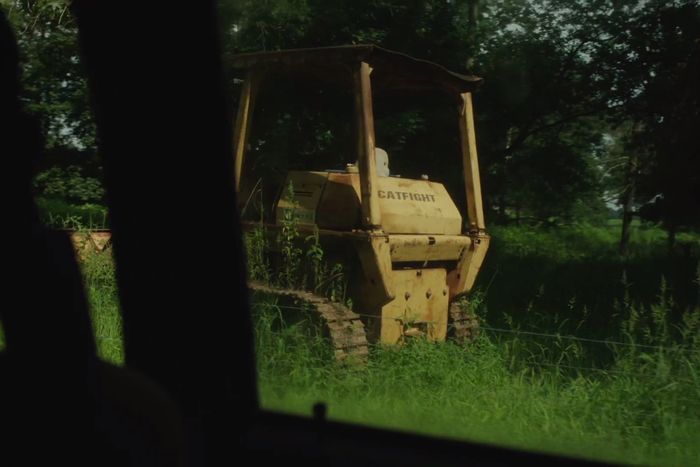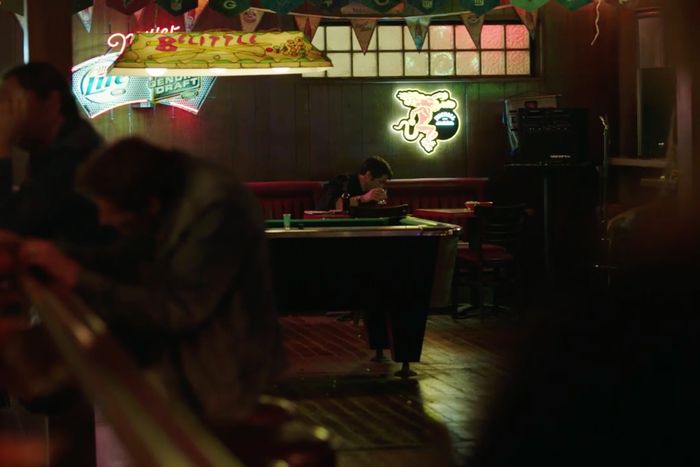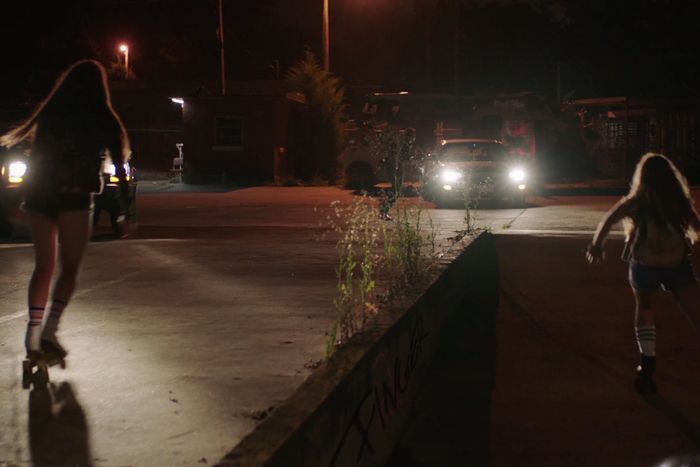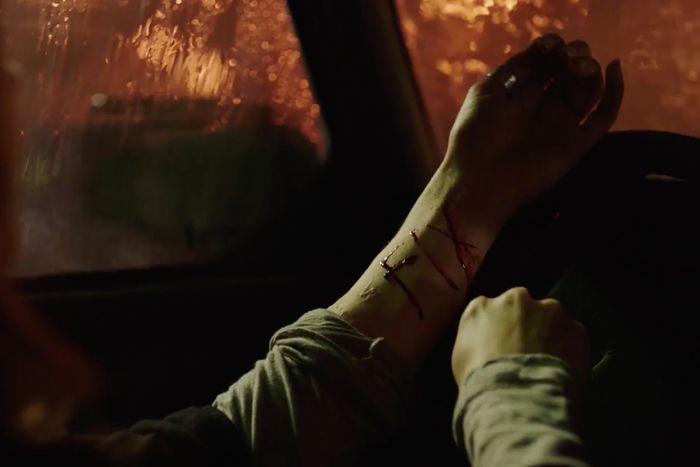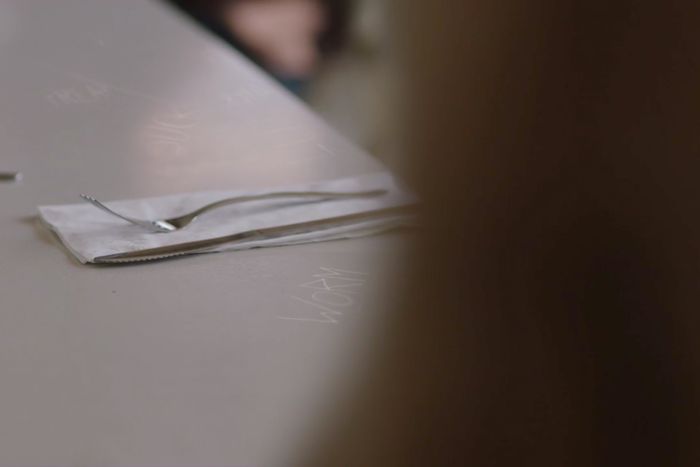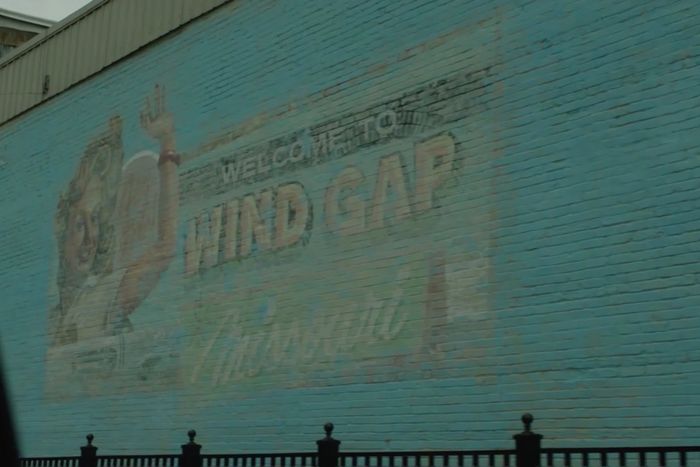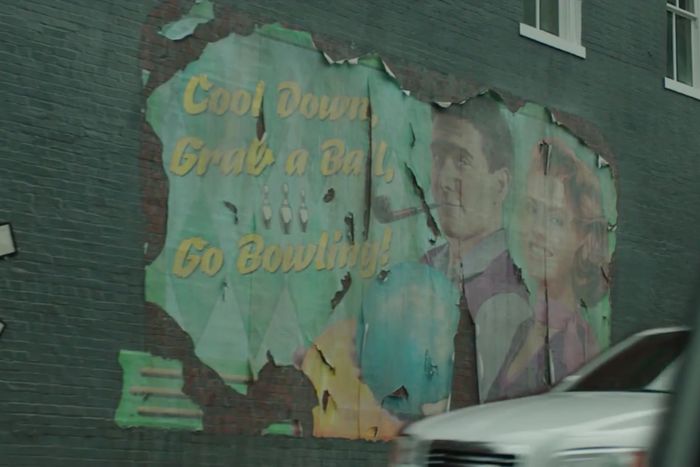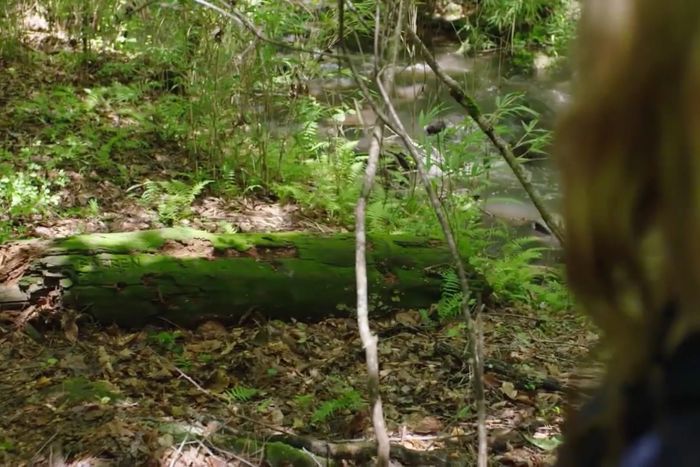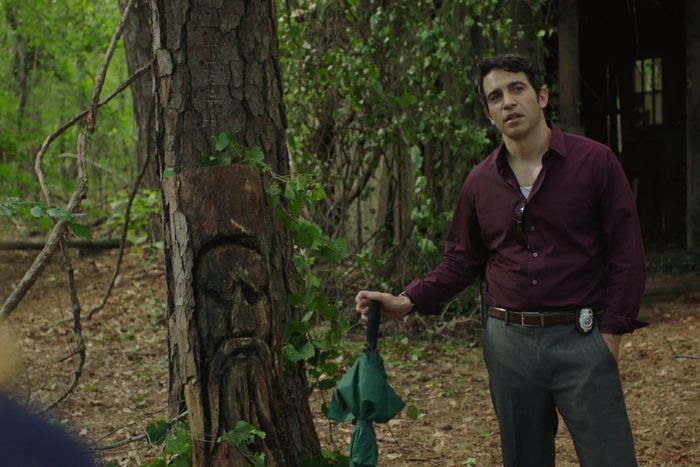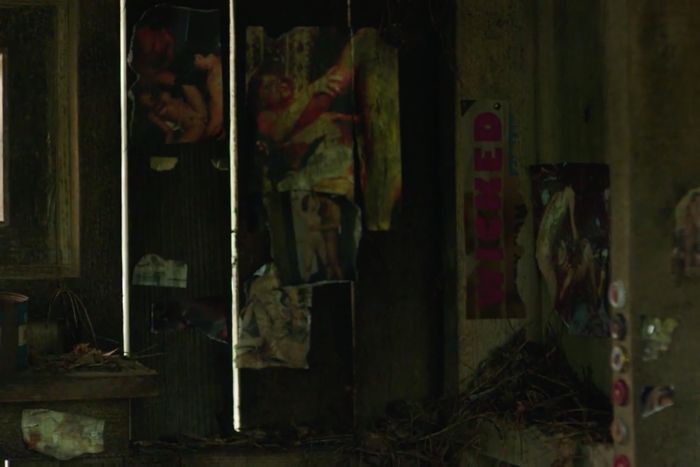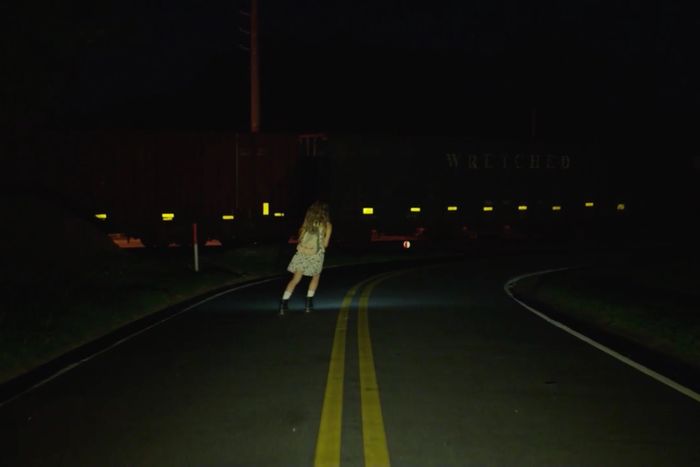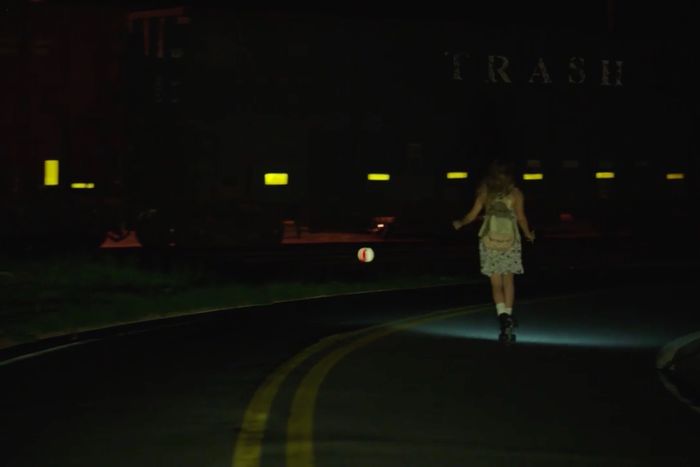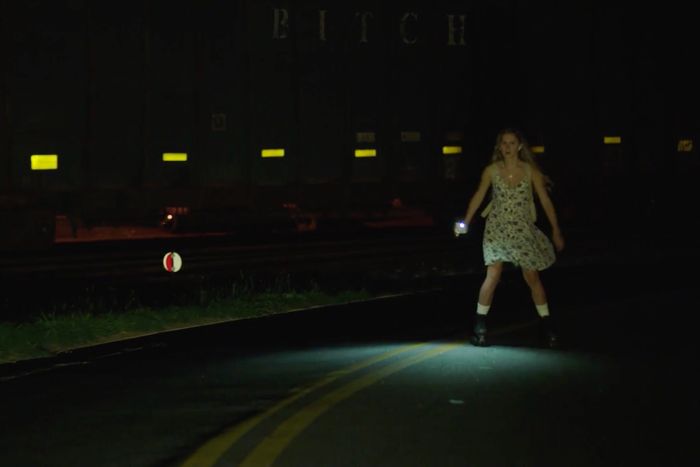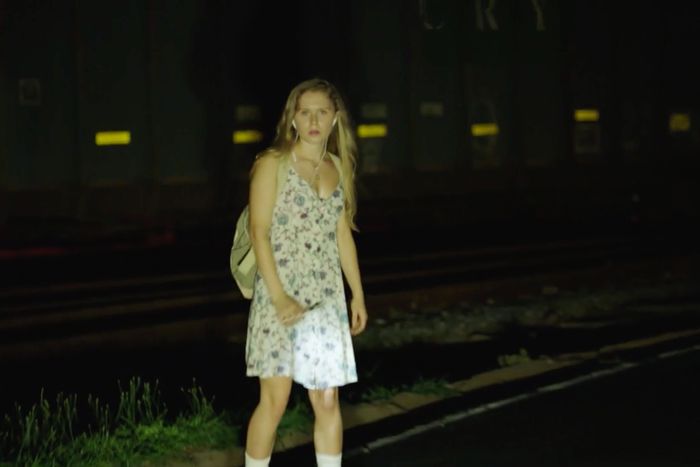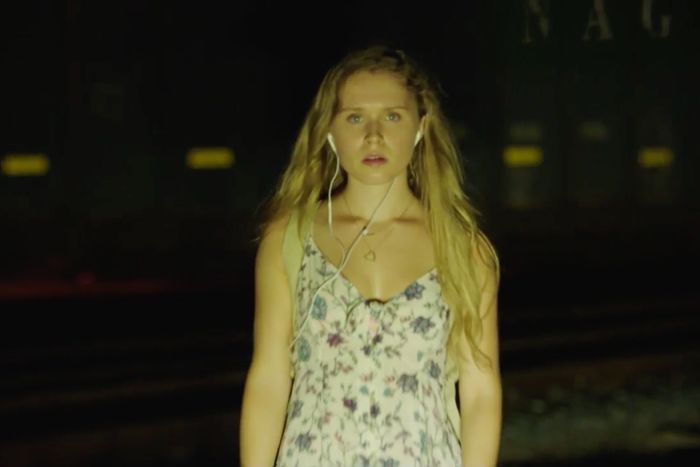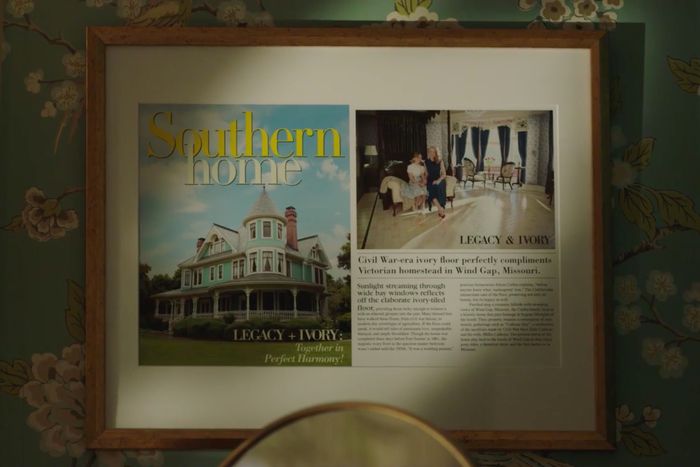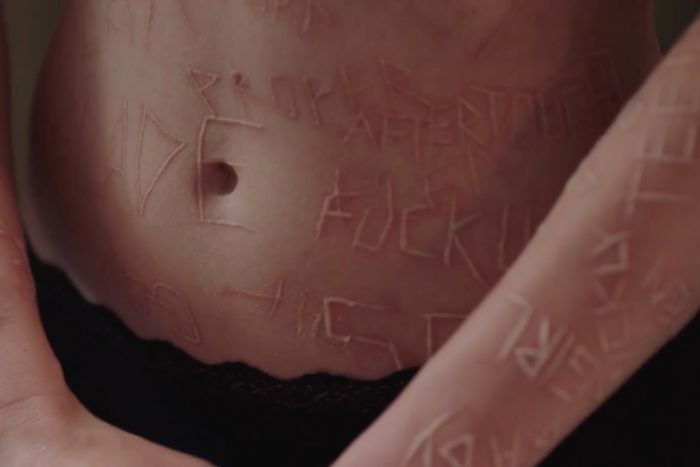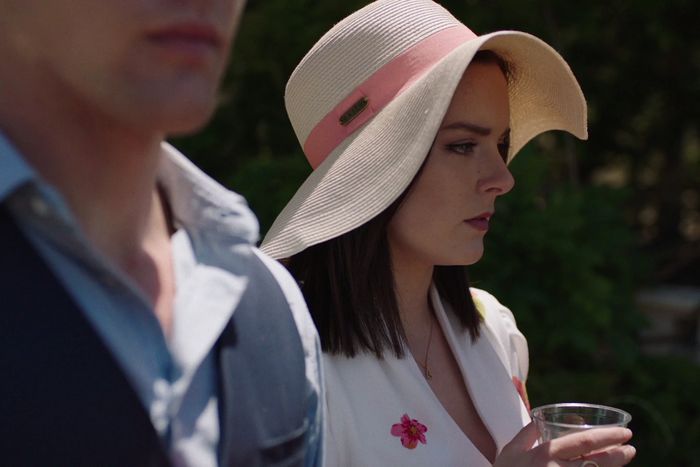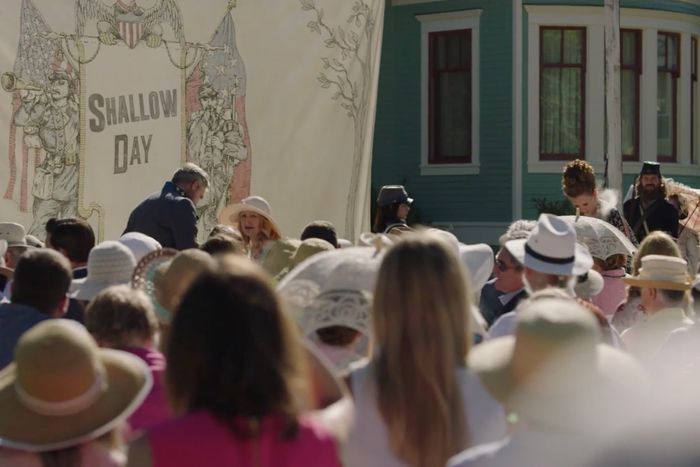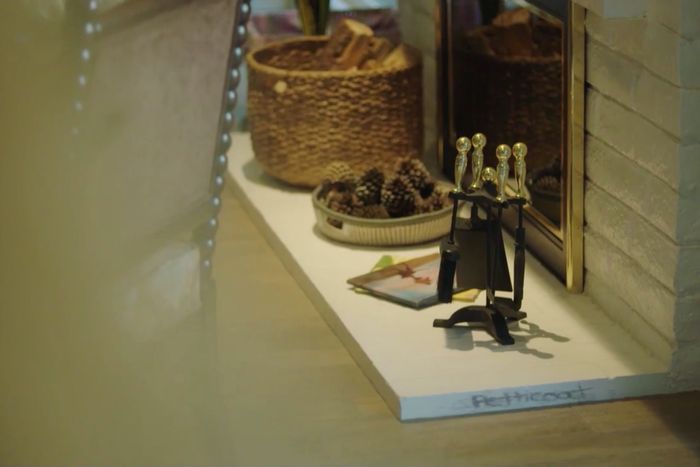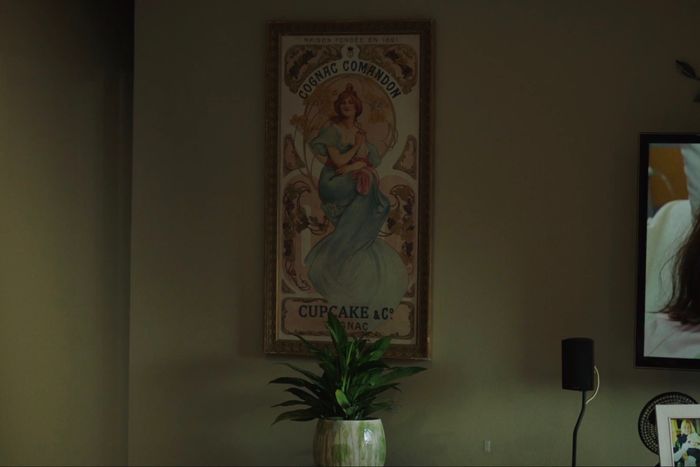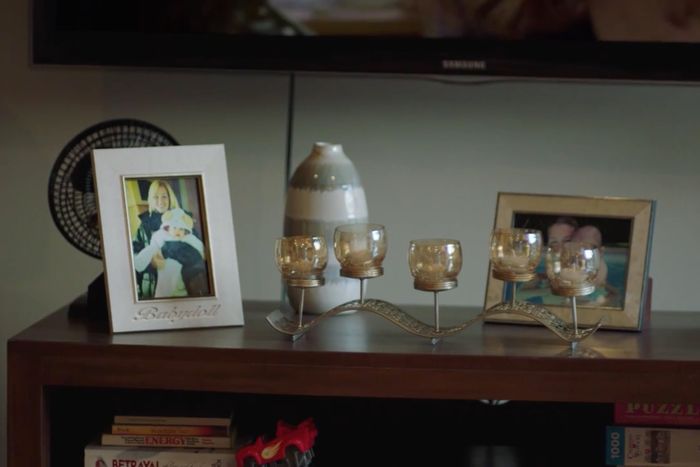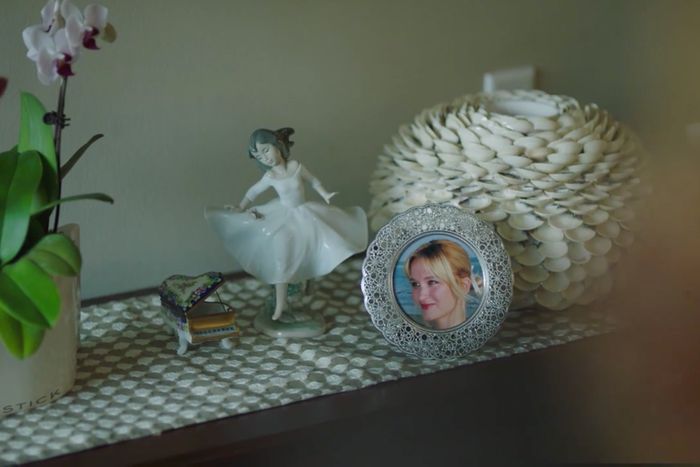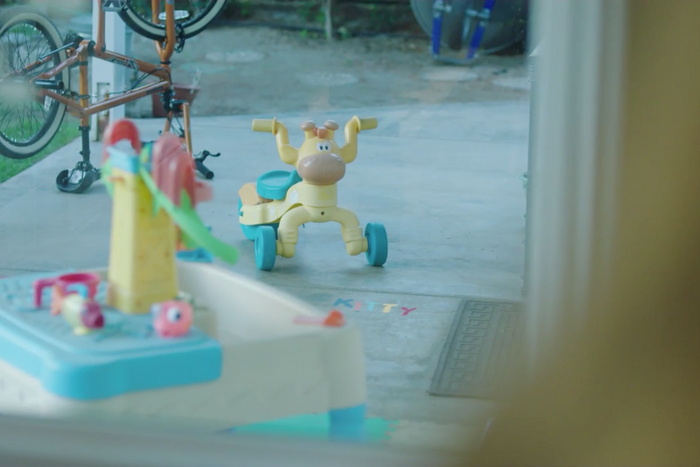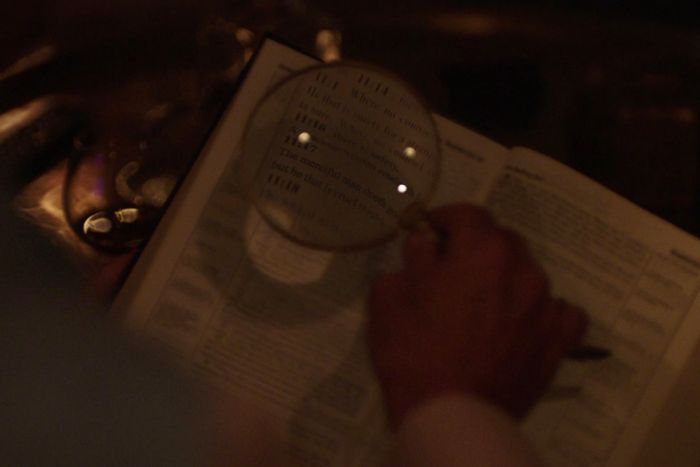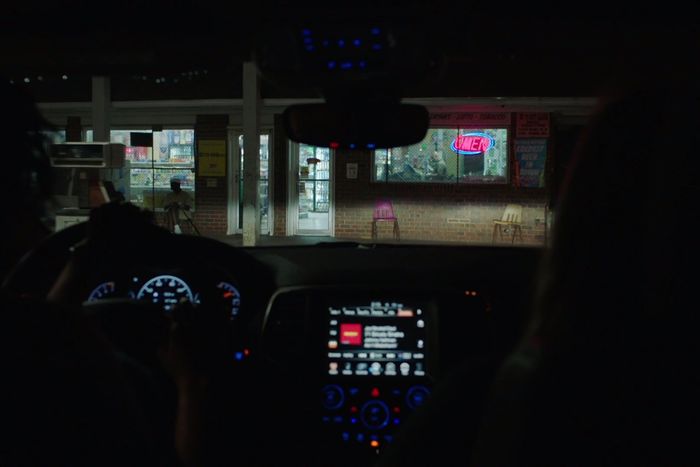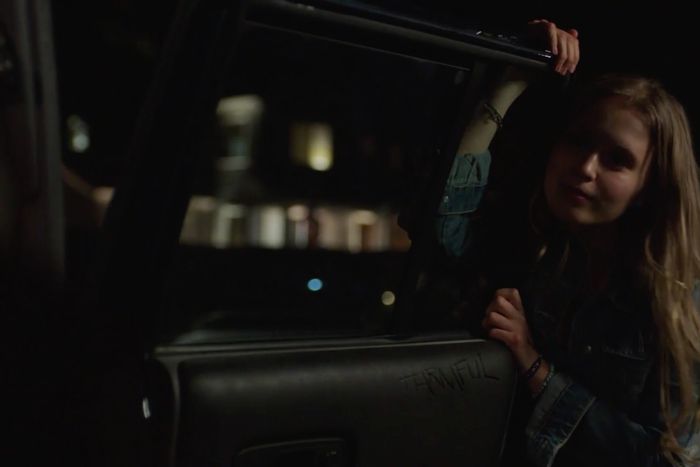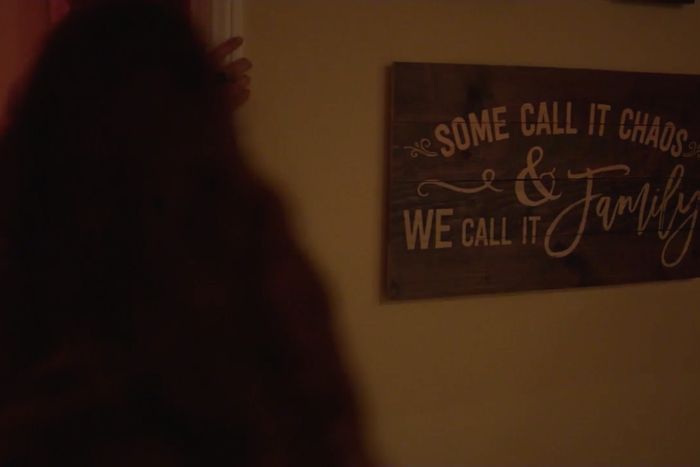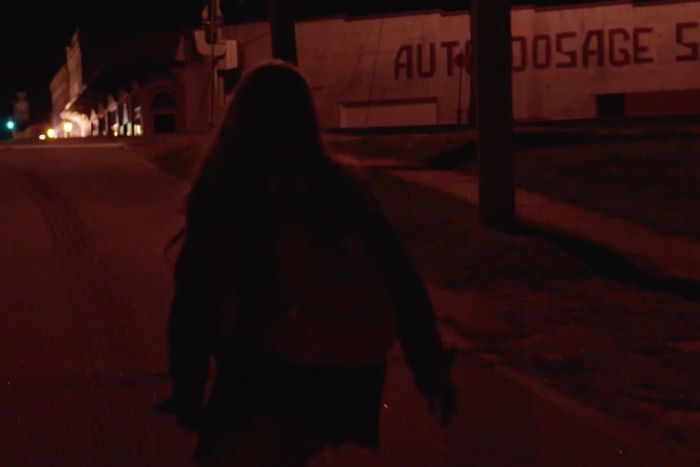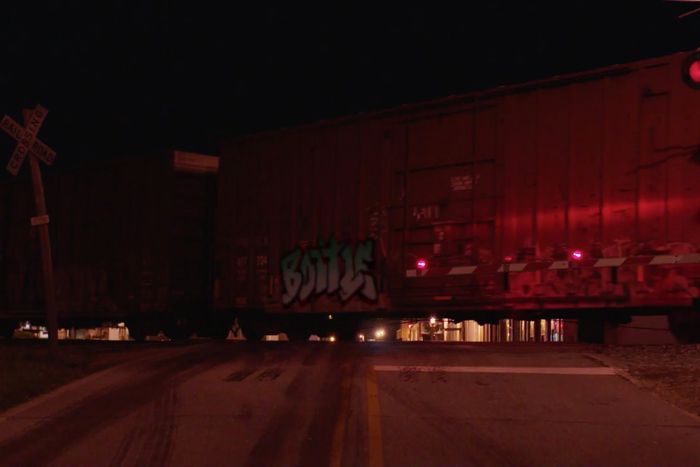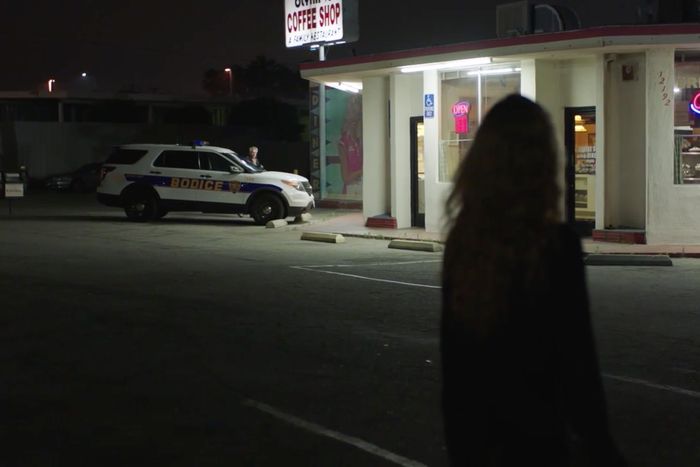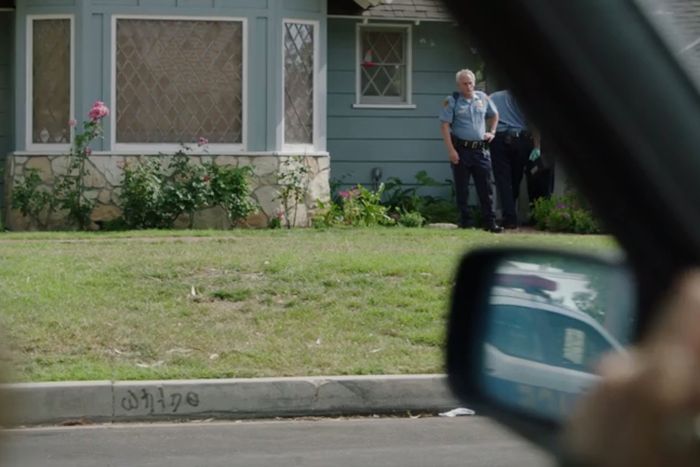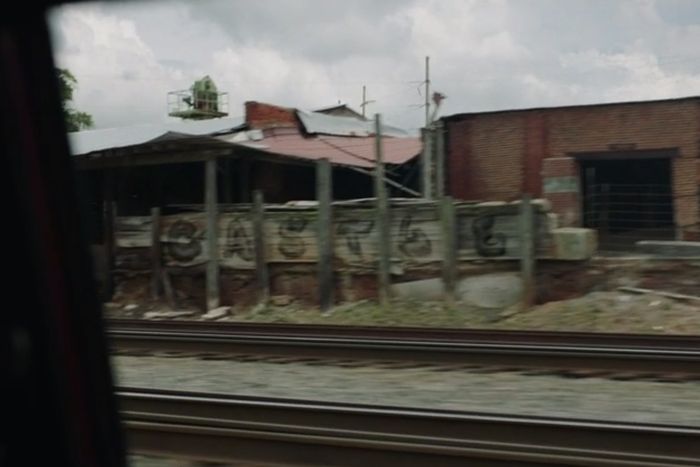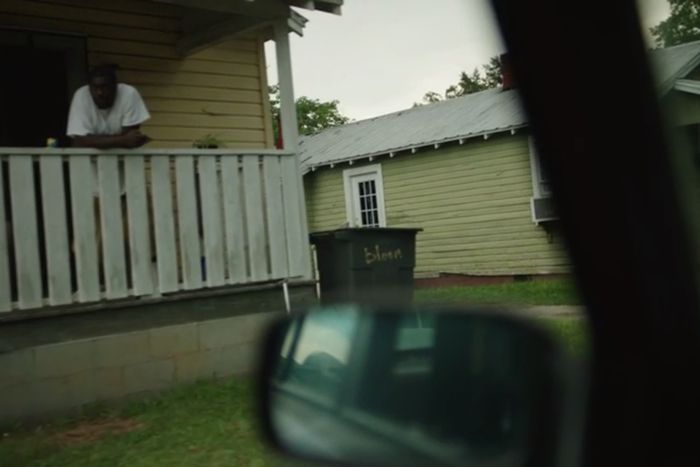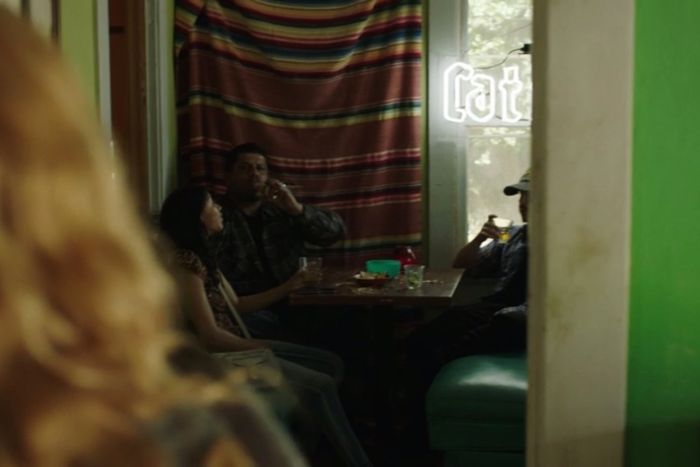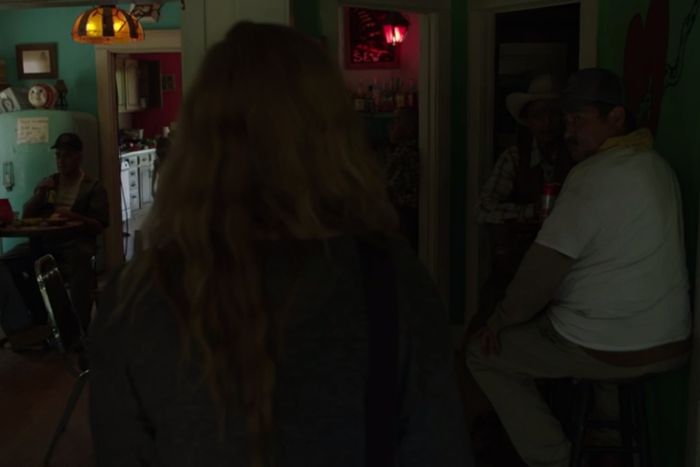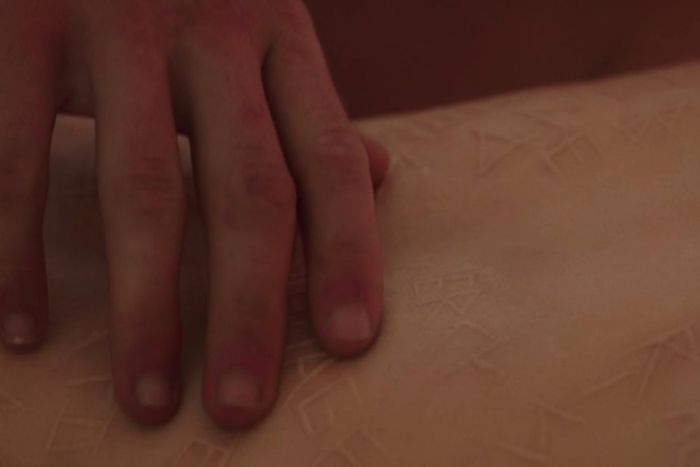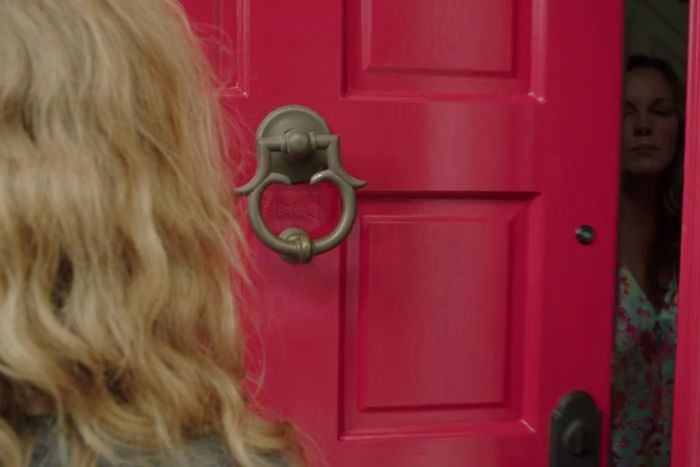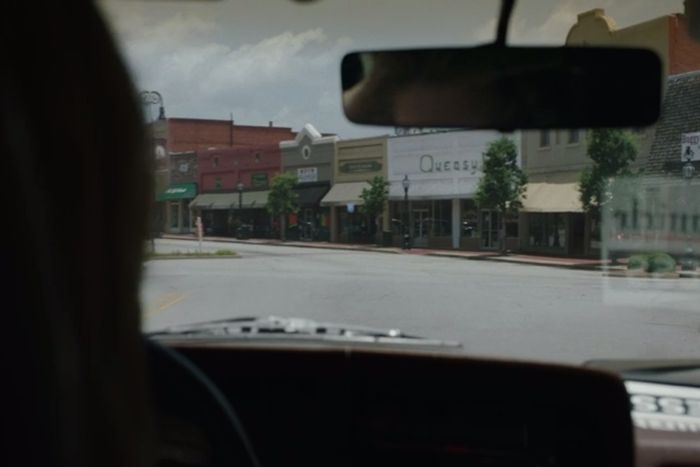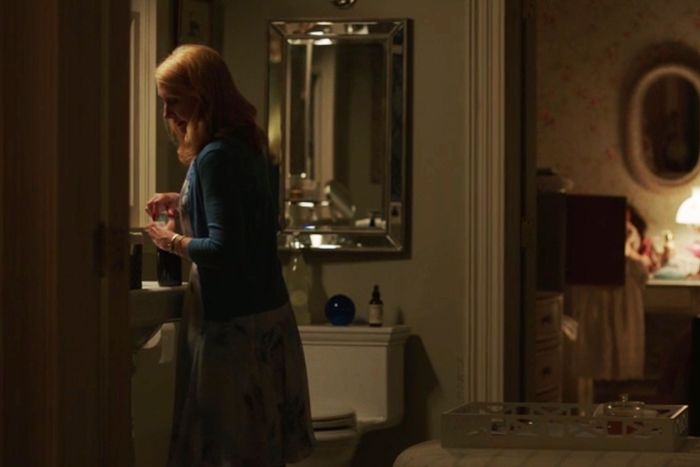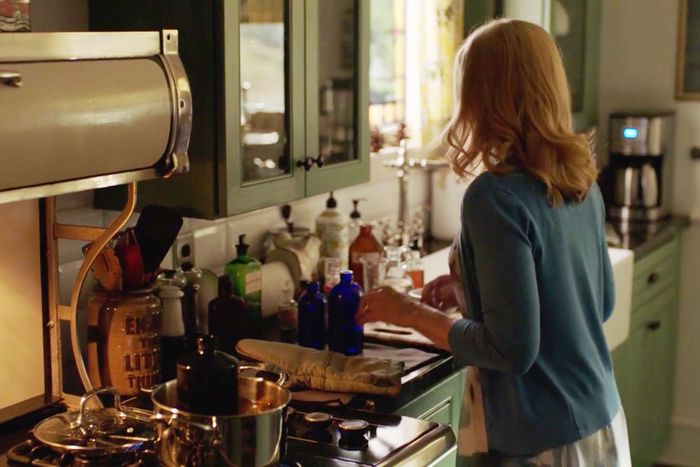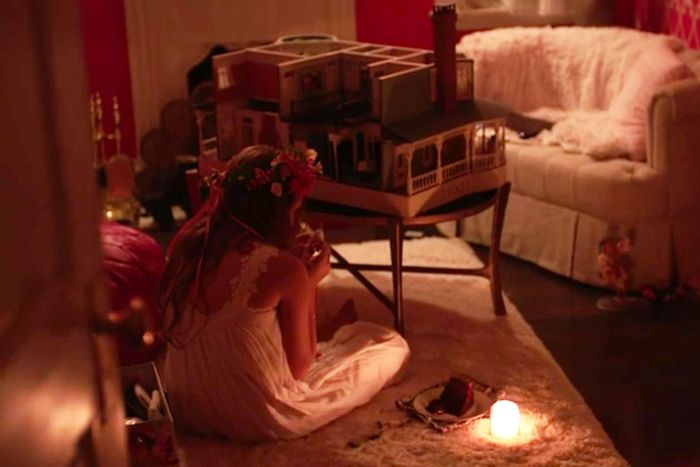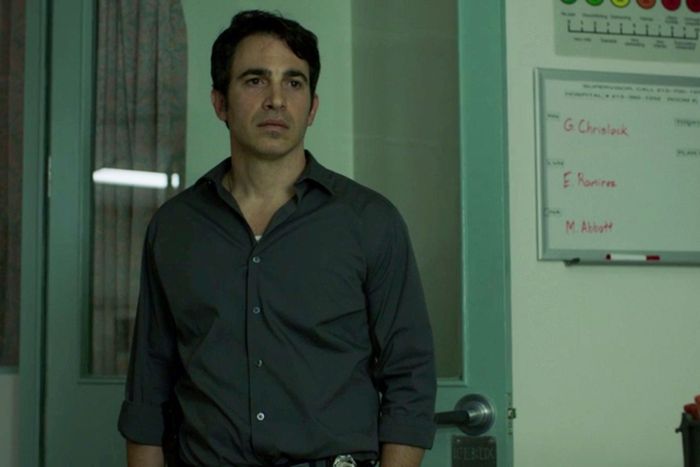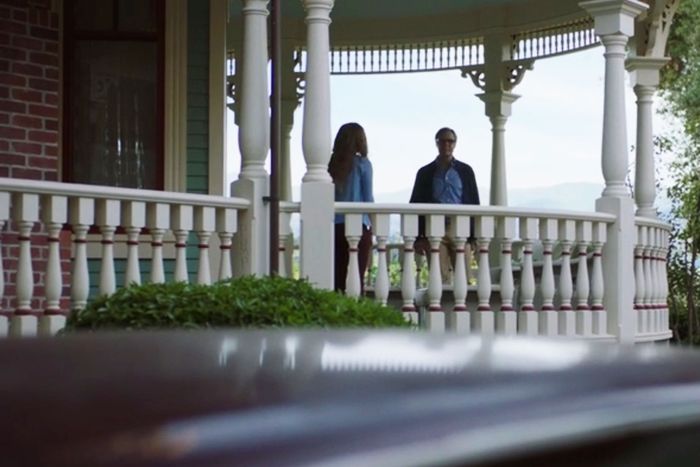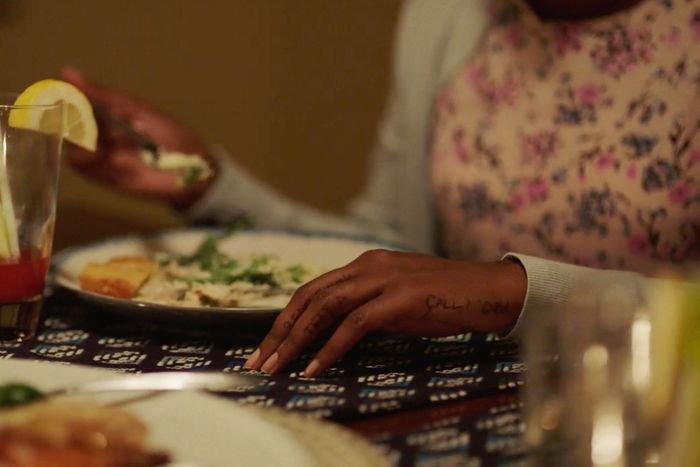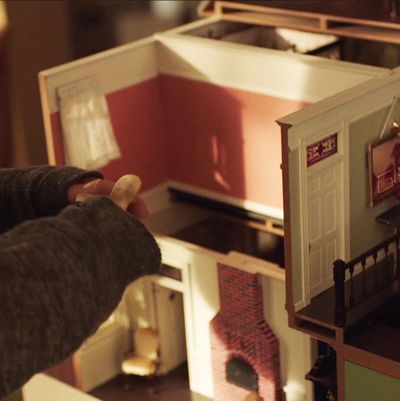
The HBO mini-series Sharp Objects is full of shadows and echoes and things you can’t quite fully glimpse — mysteries you know are there but can’t yet see, stories with contours you can’t totally make out. The hidden lines of history lurk underneath everything, but it’s also a show with words scratched on its surface. Sometimes they’re pitch-black, slantwise jokes about femininity and social expectations, sometimes they’re warning signs, and sometimes they’re straight, uninflected daggers of self-loathing.
As we discover in the last shot of the premiere episode, Camille Preaker literally carves words into her skin, turning herself into a lexicography of pain. She writes the inside words on the outside, naming and defining her story on her body. If Sharp Objects is an extension of Camille’s own self, an indication of how much its camera is also Camille’s eye, it makes sense that many of those words are also scratched and painted on the show itself. They hide in plain sight, suddenly visible in one frame and disappearing in the next.
Many of those words are hallucinatory, appearing in places that words wouldn’t otherwise show up, or you can only see them for a moment. Beyond Camille’s own hallucinations, Sharp Objects extends her fixation on words into a broader visual style, often using signage and lettering as a wry commentary on characters and their actions. These uncanny, hallucinatory images are a huge part of the show’s meticulously off-balance, unnerving feel, but they are insistently not clues — not in the traditional sense, at least. You don’t need to see them to anticipate what’s coming, nor are they a bread-crumb trail of tips to lead viewers to a hidden riddle. Their meanings are not hard to interpret: They are words from Camille’s mind, from how she understands herself, from the narrative of herself. They’re barely visible versions of everything Sharp Objects is already showing us, made explicit in language. Don’t think of them as hints; think of them as labels. Troubling, alarming, deeply scarring and scarred labels.
(An important note: Many of these words appear for only a single frame, and some are really tough to spot. This list wouldn’t be possible without help from painstaking, meticulous viewers who find all the things I did not, and who very kindly come let me know that I missed, for instance, a farm vehicle’s logo briefly becoming the word “CATFIGHT.” Credit also belongs to the community at r/sharpobjects, who go through the show with a fine-toothed comb and spot even more previously unseen things.)
“Vanish” (Episode 1)
The first hidden word we see seems completely innocuous. Camille (or someone else) has used thumb tacks to spell out “ASK!” on the divider of her cubicle in her St. Louis newspaper’s office. It’s exactly the sort of meaningless, mindless thing you’d do while sitting at your desk. And its message reads as a chipper reminder for Camille to do her job. Once you see it in the context of the rest of the episode, though, “ASK!” seems like the viewer being prodded to ask about hidden mysteries, and like Camille begging to be asked real questions. On Sharp Objects, it surely can’t be a mistake that the word is spelled out with literal pins.
Now we get into the less cheery vocab. There are many words scratched onto Camille’s desk, but the two most visible are “BAD” and “A DRUNK.”
This is the first of the clearly hallucinatory words. It could easily be something scrawled onto Camille’s dirty car with a finger, but there’s no word on the trunk in the first several frames, and then it appears suddenly. (The image also returns in one of Camille’s memory flashback sequences.)
Visible on a highway sign as Camille drives from St. Louis to Wind Gap: “Last Exit to Change Your Mind”
This one isn’t a hallucination, but it’s an example of the way Sharp Objects uses written language as part of its visual design. In a show where we already know about one murdered girl, another missing, Camille’s deceased sister, and the likelihood of other mysteries of Camille’s past, a sign reading “DON’T BE A VICTIM” falls somewhere between sincere victim-shaming and a very dark joke about the cruelty of the patriarchy.
Another of Sharp Object’s bleak jokes, there’s a sign about knowing how much alcohol you can handle lurking behind an empty glass in the Wind Gap bar.
Right before Camille passes out in her car outside the bar, her stereo system flashes a message: “WRONG”
When Chief Vickery kneels by Natalie Keene’s body in an alley, the word “YELP” is scratched on the door frame to his left.
The sneakiest one of the episode: When Amma shows Camille her absolutely fantastic, uncanny Gothic miniature dollhouse version of Adora’s southern mansion, the word “girl” is briefly visible, scratched onto one of the perfect replicas of the house’s artwork. Based on the layout of the house, it hangs right outside Camille’s room. (Also notable: Camille’s is one of the few rooms not built into Amma’s dollhouse — the tiny door to where her room would be leads nowhere.)
In the final shots of the episode, Sharp Objects gives us the reveal that will be familiar to anyone who’s read the Gillian Flynn novel: Camille’s skin is covered with scarred words. They’re all over her back and her legs, and in the final frame, the episode title, “VANISH,” appears suddenly highlighted on the back of her arm.
“Dirt” (Episode 2)
Sharp Objects hasn’t yet given a clear shot of Camille’s entire body, but we do get a flash of one scar in the montage at the beginning of the second episode.
At Natalie Keene’s funeral, a church banner that previously read “Hope” changes to “Hurt.”
As Camille sits in her car outside the memorial at Natalie Keene’s home, Bob Nash comes storming out of the house. The license plates on the surrounding cars read “BUNDLE,” “PUNISH,” and “TANGLE.”
The word “SCARED” is seen scratched on Camille’s car as she slams the door and walks into the Keene house.
Another onscreen textual joke: Camille looks around Natalie’s house and spots a girl’s pink T-shirt with “Whatever” printed on the back. It’s a fantastic encapsulation of the person Camille decides Natalie was — someone stuck inside a set of girly social expectations and restricted to a palette of pink and purple, but whose own tastes and interests didn’t conform to the feminine norm.
We then get another shot of Camille’s car door. This time, the word shifts to “SACRED.”
“Fix” (Episode 3)
By the third episode of Sharp Objects, you can start to see a pattern in where hidden words appear and what forms they take. Like this example of “faith” printed on a candle from the memorial where Natalie Keene’s body was found: It’s meaningful, and it’s a part of the show’s design, but “faith” is actually printed on this candle. (It’s shown from multiple angles in more than one shot.) This scene is from Richard’s point of view, and the words around him are stable. The words that flicker from reality into hallucination are the ones seen from Camille’s perspective, and are almost always in frames shown from the perspective of her eyeline.
This is another shot of Camille’s scars, and it’s the first time we see her deliberately showing them to someone. After checking into a rehab facility some time prior to her return to Wind Gap, she lifts her shirt so her new roommate Alice can see them. It’s a retort (“fuck u”), a threat (“fuck u up”), and a way of introducing herself (because like Alice, she’s fucked up).
The rehab facility is full of signs that act as a direct commentary on Camille and Alice’s states of mind. “Abusing yourself is also abusing others,” is the one most visible here.
As Camille looks at the intake desk, a sign in the rehab facility that otherwise reads “YOU ARE NOT INVISIBLE” briefly changes to “YOU ARE UNWORTHY.”
When Camille talks to Meredith about interviewing John Keene, the teenager’s purse is embossed with the word “PERKY.”
Wind Gap’s major industry is hog farming, with Preaker Farms as the town’s dominant business. This extremely unnerving ad with a housewife serving “delicious, nourishing meat” is a dark joke for a show where the protagonist literally carves her own skin.
It’s hard to say whether this is a real sign on a building, or a hallucinatory version of the reflection from Camille’s “working press” sign on her dashboard. The word has obviously been sharpened so it’s more visible than anything around it, though, and it appears right before Camille watches Amma sneak into the hog pens to watch the baby pigs.
As Camille drives into the Preaker hog farm while following Amma, a tractor’s Caterpillar logo briefly becomes “CATFIGHT.”
As Camille looks toward Richard sitting in the corner of the bar, the light fixture that usually reads “BILLIARDS” momentarily shifts to read “BELITTLE.”
When Amma and her band of roller-skating teens confront Richard and Camille in a parking lot, the low half-wall reads “FINGER.”
Driving way too fast in the middle of the night, Camille hallucinates seeing a ghostly young woman standing on the road. (Is it Marian? Alice? The woman in white?) The road sign to her right, which usually reads “St. Louis,” briefly becomes “SPITEFUL.”
At the end of the episode, we see the episode title while Camille flashes back to cutting “FIX” into her arm.
“Ripe” (Episode 4)
In a very brief flashback as Camille looks in the mirror, a number of words are scratched on a table. The clearest one is “WORM,” a word behind it looks like “SUCK.”
The signs painted onto walls in Wind Gap are eerily apropos for Sharp Objects’ broad thematic obsessions, and they’re often tied to images of domesticity and femininity. This cheerful, waving, braceleted woman welcomes everyone to Wind Gap; she’s both perfectly coiffed and faded almost beyond recognition.
Another entry in the town signage, this time an ad for bowling that shows us an idealized marriage, wholesome leisure time, and a reminder that the weather in Wind Gap can get very, very hot.
As Camille and Richard explore the locations of past crimes in Wind Gap, the word “BARREN” is carved onto a log behind where Richard stands. It’s a great example of the way Sharp Objects orients these words directly in Camille’s line of vision, making it clear that they’re tied to her own view of the world rather than turning the show into a more broadly surrealist work.
The scary tree face behind Richard distracts your eye from the word that appears briefly on the tree: “TEETH” carved directly above the head.
This might be an actual sign in Wind Gap’s incredibly creepy hunting cabin, but it’s just as likely one of Camille’s hallucinatory images. She sees it as she and Richard explore the woods around the town.
After Camille puts together the pieces and realizes that Amma could well be the killer’s next victim, she drives frantically through Wind Gap to search for her. The hallucinatory words appear most frequently when Camille is distraught, and in her frenetic drive through the town several appear in her eyeline. Here, a street sign reads “FALLING.”
The town’s historical signpost changes to read “RUBBER,” and “HOLLOW” is visible in graffiti on the low wall to the left.
Outside of the alley where Natalie Keene’s body was found, a sign sends yet another message to Camille: “CAN’T.”
“Closer” (Episode 5)
Episode five begins with Camille dreaming about her frenzied search for Amma. It’s a hypnotic, fast-cutting sequence of Amma roller-skating on the road, abruptly ending with Camille waking up in bed and her half-sister safely at home. In that dream sequence, Amma skates in front of a train that actually has the word “SOUTHERN” printed on the side, but the word shifts throughout the sequence.
It begins with “WRETCHED.”
Then it becomes “TRASH.”
Next comes “NASTY.”
Then “BITCH,” at the moment Amma turns around to face Camille in the dream.
This one is the hardest to make out, but it seems to read “CRY.”
And then finally, “NAG.”
The trauma associated with Adora’s ivory floor is something Sharp Objects has only gestured at until now, with Camille’s reluctance about touching it and Adora’s insistence that Gayla keep it clean. “Closer” gives us more background on the ivory floor, most notably in Camille’s memory of getting dirt on it as a child, and in Adora’s description of the floor when she gives Richard a tour of the house. For a moment, the show’s eye also rests on this framed magazine feature about the floor, titled “Legacy + Ivory.” The photo included with the article features Adora and Marian, but Camille is notably absent.
This is the first episode where we see all of Camille’s body and extensive scarring. Words are visible on her skin throughout the scene in the clothing store, but there are a few distinct close-up shots the emphasize the obvious pattern in the way Sharp Objects uses its words: The words hidden throughout the show are the words Camille scars onto herself. Here we see “GIRL,” which was hidden in the dollhouse from episode one, and “TEETH,” as carved into a tree from episode four. “FUCK U” was seen earlier, as well as “BLADE,” “PLEASE,” “AFTER,” and “PROPER.”
Again, there are multiple shots of Camille in the dressing room, and the words written all over her body are visible throughout. But there’s at least one more important close-up, where you can see the word “WRONG” etched onto her skin. (“WRONG” was previously hidden on the stereo system from Camille’s car in episode one.) The shot is notable for the word’s placement. All of the words are labels, all of them make up a web of self-identification, external limitations, social constraints, and fears. But “WRONG” is right there on her sternum, the place where you put your hand for emphasis when you’re saying your own name. If all the other words make up a constellation of meaning, “WRONG” is the North Star. (Also notable: “RIP” is directly beneath it.)
The ribbon around Ashley’s hat has a label that reads “HATCH.”
Wind Gap’s Calhoun Day celebration has signage everywhere, but for the most part, the words remain stable. A brief exception: For a moment, the curtain that conceals the stage before Amma’s performance in the Calhoun Day play reads “Shallow Day.”
“Cherry” (Episode 6)
At the very beginning of the episode, as Camille stumbles through the woods searching for Amma, she trips and reads “CURLS” on a log. It looks like “BARREN,” from her earlier conversation with Richard in the woods, but the shot most closely resembles Camille’s memory of being assaulted by football players while in high school — more than once, she’s had a flashback to a similar image of herself examining her own hand on the ground, with bugs crawling around it.
What follows is one of my favorite hidden-word sprees the mini-series has done so far. After Camille is bullied into a girls’ day with her old high school cheerleading friends, she glances around the house — the same one her friend just bragged about, reminding Camille what she could’ve had if she’d stayed in Wind Gap — and sees words everywhere. First, we see “PETTICOAT” written in pencil at the bottom of the fireplace, and they’re all specifically related to reproduction and femininity. In an especially deft touch, a home like this could be decorated with nearly identical words: As Sharp Objects shows us later in the party scene, home décor is often proudly about self-labeling, especially when related to ideas of faith, identity, and feminine domesticity. Most of these words are from Camille’s imagination, but they’re a short step away from a plausible reality.
Then “CUPCAKE” as part of a vintage poster.
Then we see “BABYDOLL” printed underneath a picture frame, and this is the shot that makes it clear Sharp Objects is playing with the porous border between Camille’s hallucinations and a particular aesthetic of home décor. “BABYDOLL” may not be a vision. It’s paired with a photo of a mother and child, and I’m confident you could buy a frame exactly like that from HomeGoods. Similarly, “ENERGY” and “BETRAYAL” may be the real titles of those books on the shelf underneath, but they’re indistinguishable from Camille’s hallucinations, and so the real and surreal bleed into one another.
Appetizer bowls on the table, which spell out “COCK.”
“LIPSTICK” printed on a vase.
Another word that sits deliberately on the border between reality and illusion: “KITTY” printed in chalk on the sidewalk near a kid’s toy. Nothing about the word “kitty” makes it inappropriate or unlikely for a child to have actually written it, but if we see it as one of the set of Camille’s imagined words, the word’s meaning shifts, pulling more in the direction of sex and femininity.
Alan is reading from Proverbs 11:17, a verse with some literal-sounding suggestions about self-inflicted bodily wounds: “The merciful man doeth good to his own soul, but he that is cruel troubleth his own flesh.”
In the aftermath of the cheerleader reunion, Camille and Becca pull up to a liquor store. For one moment, the open sign reads “OMEN.”
As Amma goads Camille into joining her at this teenage house party, we can see “HARMFUL” scratched onto the car’s upholstery.
The domestic words from the first half of the episode are mostly in Camille’s mind, and when Amma drags Camille to a high-school party, we get multiple examples of the real-world versions of that aesthetic. My favorite is this one, in the house’s stairwell, a sign meant to be cutesy that’s instead acting as a wryly on-the-nose comment about Camille and her family history.
The episode title, “CHERRY,” is printed on the back of the DJ’s laptop.
The words return as Camille and Amma get high and roller-skate through Wind Gap. Here, we see “DOSAGE” on the side of a building.
Very quickly, the word “DUMPLING” flashes on the railroad crossing sign.
“BOTTLE” is graffitied on a passing train.
As Amma and Camille skate past the diner, the sign on a Wing Gap police car briefly becomes “BODICE.”
“Falling” (Episode 7)
As we get more and more examples of the way Sharp Objects deploys hidden words, patterns begin to emerge. I’ve already discussed the way the words appear only from Camille’s perspective — we see them when the camera is a stand-in for where her eyes would be, or in a shot that replicates what it’d be like to stand right behind her, looking over her shoulder. Another pattern that’s become clear is that the hidden words tend to cluster around Camille driving. There are some practical reasons for that: It’s an easy opportunity to swap out the lettering of signage, turning highway signs and storefronts into other things. But it also plays into the story Sharp Objects is telling about Camille, about where she’s comfortable, and about how the words are woven into her feelings about Wind Gap. The words are labels and accusations and assessments, and a lot of that comes from Adora. Even more, though, the words come from the claustrophobic, intrusive pressure of Wind Gap. Camille sees words as she’s driving around her hometown because they’re how she sees this place, and how she feels it sees herself.
When Camille drives past the Keene house and realizes the police are looking for John, the word “WHINE” appears on the curb.
Again in the car, while searching for John Keene, Camille drives past a short series of words scrawled onto the town’s surfaces. This one, “CASTLE,” is another example of Camille’s (and the show’s) wry sense of humor — a word about an enormous fortification, painted onto a dilapidated train car.
Like “KITTY” from an earlier episode, the word “LITTLE” appears written in chalk on the driveway, blending in as part of a hopscotch game.
I went back and looked at this word several times, because it only appears for a moment. I initially assumed it was “blame,” which is an easy association with a story about crime, and with how Adora treats Camille. But on further examination, I think it’s “bloom” — in this context, a word with even more sinister connotations about adolescence and femininity and stunted growth.
As Camille walks into the bar looking for John, the word “Cat” appears in neon lighting against the window.
Then the word “SEW” is written on a board, illuminated by a red lamp.
When Camille and John lie in bed together in the hotel, we get the clearest images of the words she has scarred onto her own body. John reads several of them aloud: “drain,” “cherry,” “sick,” “gone,” “wrong,” and “falling.” I don’t think it’d be especially illuminating to go through and name every word on Camille’s body, and the show makes that exercise feel really unappealing. It’s just too personal. I’ll note just one: The word John kisses on Camille’s back is “MERCY.”
When Camille knocks on the door to Jackie’s house, looking for answers about Marian’s health records, the word “BLEED” appears framed inside the door knocker.
The easiest hidden word to spot from episode seven. As Camille finally puts the pieces together about what Adora’s been doing to Amma and about what she likely did to Marian, a storefront sign changes from “English” to “QUEASY.” It’s the sickness that Adora creates, and the sickness Camille feels.
“Milk” (Episode 8)
After eight episodes of words strewn throughout Sharp Objects, you might come away with a sense of them as sneaky, or even a bit defiant. As I described at the very beginning of this post, the words never coalesce into a system of clues, and they never point the viewer anywhere we weren’t already looking. They’re just exactly what the words say: “WRONG” and “FALLING” and “CATFIGHT.” You have to look for meaning in the word itself; there’s no tie back to a code or deeper message.
But one thing they do remarkably well is put us inside Camille’s point of view. Representing a character’s perspective onscreen is notoriously difficult; it often requires resorting to the blunt weapon of voice-over. (Or, in the case of a show like Mr. Robot, an unreliable narrator, which means everything is destabilized.) But the hidden words of Sharp Objects are a masterful way to negotiate between different perspectives, both subtler and more effective. In the scenes where Camille is absent or where we’re looking at her from the outside, it’s as if we’re watching a show with a third-person narrator, an omniscient voice that tells us the story from on high. But when we see the hidden words, we’re pulled back into Camille’s mind.
The first hidden word of the episode comes during the unnerving final Crellin family dinner, a meal full of mythological references: “WIDOW” is just barely printed on the knife being used to cut the ham, a word that circles back to Amma dressed as Persephone, the literal wife of the underworld. It also makes you wonder what happened to Camille’s father.
As Adora gleefully begins the process of poisoning Camille, the word “NURSE” is printed on the wall near the doorframe.
Camille wakes up and looks around her mother’s room, contextualizing the house with the horrors it’s contained. In particular, she recalls her sister Marian, killed by Adora’s caring. “SICKLY” is printed on the green chair.
Another entry in Sharp Object’s bleakly funny commentary on self-labeling in domestic decor: As Adora prepares more poison for her daughters, the utensil container nearby reads “ENJOY THE LITTLE THINGS.”
While Camille looks into Amma’s room, the wall of the dollhouse reads “TICKLE.” (Or is it “PICKLE”?)
Finally rescued from their mother’s clutches, Camille and Amma listen to Richard explain the facts they’ve put together. The word “ICEBOX” is printed on the door plate. It’s a word that implies morgues and preservation, and in a show where so many of the images have dealt with ripeness, heat, and alarming fecundity, it’s a word that suggests everything is suddenly frozen.
Amma and Alan have an awkward final interaction while Camille looks on; the word “PUMP” is printed on one of the vertical posts.
As Amma and Camille exit the prison after Amma visits Adora, the side of the trash can reads “BACK.” It’s one of my favorite hidden words of this episode. Amma is incapable of moving on to a new life with Camille and has to go back to Adora, Jackie arrives and pulls Camille back to the memory of Wind Gap, and it’s a signal that the mystery hasn’t been fully resolved. Camille tries to move ahead, but she’s not finished yet.
The episode’s title, “MILK,” is printed on Mae’s hand.
This scene is the signal of impending doom for Amma’s new friend Mae. Amma killed Ann and Natalie after Adora grew close to them, jealously guarding her relationship with her mother. At this dinner, Mae talks about wanting to be a writer like Camille, and then Camille sees these words printed all over her hands. It’s not clear if they’re actually there or if the words hallucinations. They may well actually be there, in the same way previous hidden words could easily have been children’s chalk writings. The words are plausible as something a teen would write on her hands: “CALL MOM,” “TEXT A,” and “READ BOOK.” Amma also seems to notice them, which suggests that they’re not just in Camille’s imagination, and Amma would surely put together the resonance between Mae’s self-scribing and Camille’s scars. But they’re oriented in a way that would be difficult for someone to write on themselves — not impossible, but tough. It doesn’t matter if they’re real, in the end. Amma sees Camille looking at Mae intently, and that attention is enough to doom her.



